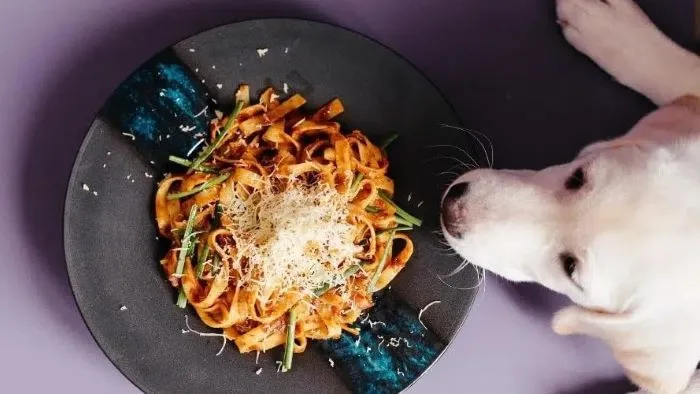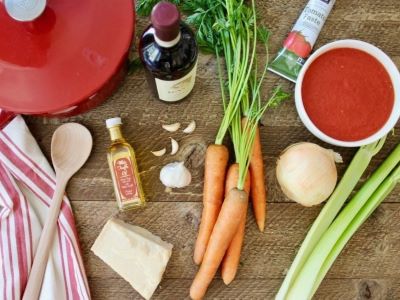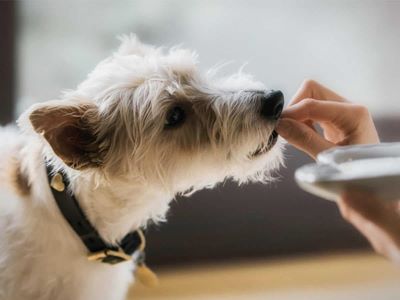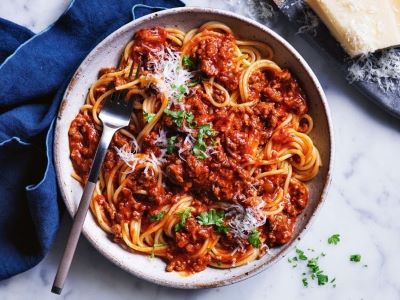Spaghetti bolognese is the best twirly treat. When the family gather around the food table it’s fun family time, but there is one special member who looks at you with dreamy eyes asking you to share it, but “Can dogs eat spaghetti bolognese?“🍝
In this article, we are going to find out how can we feed pasta to our dogs. So, without further ado take your ‘fork’ folks and dig in….🍽️

Can Dogs Eat Spaghetti Bolognese?
Well, the short answer is maybe! Dogs can have some pasta now and then, but we gotta be careful. Let’s break down the pasta tale into bite-sized pieces, starting with what’s in that tempting dish.
- Minced Meat: Typically beef or pork.
- Tomato Sauce: Bursting with tomato goodness.
- Onions and Garlic: For that flavour kick.🧅
- Herbs and Spices: Like oregano and basil, for that authentic taste.
- Pasta: The star of the show.
Now here are the potential hazards that are, “Onions and Garlic can be toxic for dogs, affecting their red blood cells”, says Renee Schmid from VCA Hospitals.
High-fat content like Fatty foods can lead to pancreatitis in dogs. Herbs and Spices can upset your dog’s stomach Also, Salty Sauces cause too much salt is a recipe for disaster for your dog’s health[1].
While spaghetti🍝 bolognese sounds tempting this can turn into trouble quickly. That’s why it is always advisable to feed them in moderation.

Safe Alternatives
Let’s see what can you feed your dog if you want to replace the past, but still feed something nice:
Lean Meat Bites: Opt for lean meats like chicken or turkey. Cooked without excessive oils or spices.
Veggie Delight: Steam some dog-friendly vegetables like carrots or green beans. These add crunch and nutrients without the calorie overload.🥕🫑
Whole Grains Goodness: Cook up plain brown rice or quinoa. A great source of energy for your dog.
Dog-Friendly Recipes:
Now, let’s get our aprons on and whip up some dog-approved delights!
1. Chicken and Sweet Potato Stew
Ingredients: Chicken breast (cooked and shredded). Sweet potatoes (cooked and mashed). Carrots (chopped). Peas (frozen or fresh). Water or low-sodium broth.
Instructions:
- Cook the chicken thoroughly and shred it.
- Mash the sweet potatoes.🥔
- Combine chicken, sweet potatoes, chopped carrots, and peas in a pot.
- Add water or low-sodium broth and simmer until veggies are tender.
- Let it cool before serving it to your pup.
2. Veggie Rice Bowl
Ingredients: Brown rice (cooked), Broccoli (steamed), Spinach (chopped), and Blueberries (fresh or frozen).
Instructions:
- Cook brown rice according to package instructions.
- Steam broccoli until tender.
- Mix rice, steamed broccoli, chopped spinach, and blueberries.
- Serve to your dog once cooled.
Remember, the key is to keep it simple, fresh, and according to your dog’s choices.

Risks and Concerns
Giving in to your dog’s every food choice can have some unpleasant results, some of which are food allergies: Let’s see them in detail:
1. Overeating
Feeding your dog large portions or an unfamiliar diet can lead to upset stomachs. Watch out for vomiting, diarrhoea, or general signs of discomfort.
Rapid changes in diet might cause digestive distress. Introduce new foods gradually to allow their system to adjust.
2. Allergies
Dogs, like humans, can have food allergies. Keep an eye out for itching, swelling, or digestive upset after introducing new ingredients.
Ingredients like dairy, wheat, and certain proteins may trigger allergic reactions. Consult your vet if you suspect allergies and consider an elimination diet.
3. Seasonings and Spice
Onions🧅 and garlic are a no-go for dogs, as they contain compounds that can damage red blood cells. These ingredients might be present in many human dishes, including pasta sauces.
Dogs are sensitive to excessive salt intake. High sodium levels can lead to dehydration, increased thirst, and sodium ion poisoning.

Dogs’ taste buds aren’t designed for spicy foods. Spices like chilli or pepper can cause digestive upset and discomfort. Now, let’s see some tips to keep your dog healthy:
- Before introducing new foods, consult with your vet to ensure they align with your dog’s dietary needs.
- Check ingredient labels on commercial dog treats and food. Avoid items with hidden dangers like onion powder or excessive salt.
- When cooking for your dog, steer clear of ingredients like onions, garlic, and excessive spices. Stick to canine-friendly recipes with vet-approved ingredients.🧑⚕️
- Monitor your dog’s behaviour, stool consistency, and overall health when introducing new foods. Any sudden changes should be discussed with your vet.
4. High-Fat Content
Dogs can’t handle rich, fatty foods as well as humans. High-fat content may lead to pancreatitis, causing severe abdominal pain and distress.
Limit fatty treats and ensure a balanced diet. Opt for lean proteins and healthy fats in moderation.
Signs of Allergic Reactions or Discomfort
Your dog may not speak your language but they have different ways of telling us that they are feeling off. Understanding the dog’s signs of discomfort can help you prevent the situation from getting worse.
- Itchy Skin: Excessive scratching, biting, or licking. Red, inflamed skin, especially around the ears and paws.
- Digestive Upset: Diarrhea or vomiting. Changes in stool consistency or frequency. Excessive gas or bloating.
- Respiratory Distress: Sneezing, coughing, or wheezing. Difficulty breathing or excessive panting.
- Swelling: Swollen face, muzzle, or limbs. Look out for sudden changes in your dog’s appearance.
- Ear Infections: Frequent head shaking or pawing at the ears. Unusual odour or discharge from the ears.👂
- Lethargy: Unusual tiredness or lack of interest in activities. A decrease in overall energy levels.
If there are sudden and unexplained changes in behaviour or appearance. Dogs may not always show pain in obvious ways, so any deviation from the norm should be investigated.

Precaution and care
Seeing your suffering from an allergic reaction can be painful, but quick and right steps can make a difference. Try to identify and remove the source of the allergic reaction.
If it’s a specific food, treat, or environmental factor, remove it from your dog’s surroundings. Call your vet immediately to seek advice. If your dog has been diagnosed with allergy medications, follow the vet’s instructions carefully.📃
Create a quiet, safe space where your dog can rest. Keep a close eye on your dog’s breathing. Watch out for any swelling. If advised by your vet, be ready to take your dog to the clinic.
Choose hypoallergenic dog food, avoid certain treats, or make environmental changes if necessary. Remember, every dog is unique, and their reactions to allergens may vary. In case your dog is allergic then act swiftly and stay calm, you have got it!
FAQs
❓Can Dogs Eat Spaghetti and Pasta?
All dog breeds can tolerate pasta, so long as their owners feed it to them plain and in a moderate amount. Since all types of pasta are high in carbohydrates, a small sampling can sometimes serve as an energy booster for your pet.
❓Can Dogs Eat Spaghetti Bolognese?
You might be tempted to give some of your spaghetti Bolognese leftovers to your dog or cat but you might want to think twice before emptying it into their bowls. Giving onions and garlic to your pet can cause health problems, so it’s best to avoid sharing any dishes including these vegetables with your pet.
❓What if My Dog Accidentally Ate Garlic?
Your pet also could develop abdominal pain and discoloured urine. While vomiting and diarrhoea may occur within one day, it may take several days to a week after your pet eats garlic for symptoms of anaemia to appear.
❓Can Dogs Eat Cooked Spaghetti?
Cooked pasta by itself is not toxic to dogs and can be given to them in moderation as an occasional treat. However, pasta should not make up a significant portion of a dog’s diet, as it is not nutritionally complete and does not provide the balanced diet dogs need to maintain good health.
❓Is Chocolate Toxic to Dogs?
Yes, chocolate is toxic to dogs. While rarely fatal, chocolate ingestion can result in significant illness. Chocolate is toxic because it contains a chemical called theobromine, as well as caffeine. Theobromine is the main toxin in chocolate and is very similar to caffeine.
Conclusion
In conclusion “Can dogs eat spaghetti bolognese?” We’ve reached the bottom of this gravy pot by feeding spaghetti to our dog. 🍝
So dogs can eat spaghetti bolognese but in moderation, with vet approval. Just be sure to not feed them garlic, onions, extra salt and fat. Stick to plain noodles, lean meat, and simple sauce. Portion control is key too, ya hear?! 🧅
Most of all, for all things food, check with your family vet first. They know your dog’s needs best! Just be wise, and moderate, yet devour this homemade meal. Now who wants a treat?
Reference:
- Can Dogs Eat Salt? | PetMD



